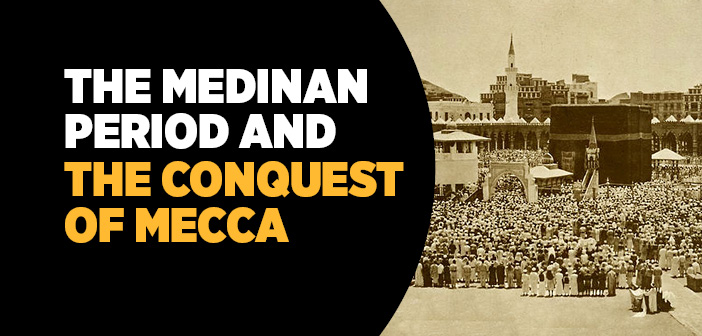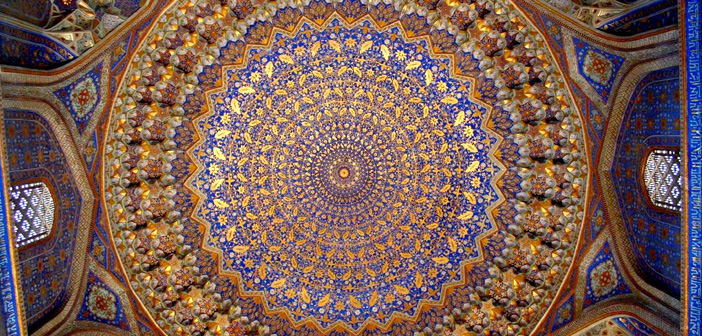What was the situation of medinan period? What is the conquest of mecca?
In Medina the Prophet (peace and blessings be upon him), structured a treaty for all the inhabitants to live in peace; it meant equity for all, governed by the Prophet and mutual consultation. However, soon afterwards this new emerging community was faced with external challenges, such as, the Quraysh increasing their assault by first confiscating the valuables of the Muslims that they had left in Mecca and selling them through caravans heading towards to Syria. In relation to these circumstances, the Muslims were given divine allowance to fight against their oppressors and in due time the battles of Badr and Uhud were fought between the two sides. The Prophet (peace and blessings be upon him) and the Muslims engaged in these battles with great discipline, by avoiding injury to the innocent and by using only the minimum force required. By the year 627 CE, the Quraysh allied themselves with one of the Jewish tribes of Medina and some of the other Arabian tribes and attacked the city of Medina. During this battle of the Trench, the Muslims lost many men while defending their city and religion. This resulted in many widowed Muslim women and numerous orphaned children. In such challenging and difficult circumstances of war, the Prophet Muhammad married several women during this period of his life. All of the women he took as wives were either widowed or divorced, except Aisha.[1] A year after the Battle of Allies (Trench) in 628 CE, the Prophet and fifteen hundred of his companions left for Mecca to perform the annual pilgrimage. Unfortunately, they were barred from approaching Mecca by the Quraysh at a place called, ‘Hudaybiya’, where following some negotiations a treaty was signed, allowing for the Muslims to come for the performance of the pilgrimage the following year and to allow for ten years of peace. This treaty facilitated the growth and spread of Islam amongst the people of the whole region without interference. Many delegations from all regions of Arabia came to the Prophet to investigate the teachings of Islam. A large number of people accepted Islam within a couple of years. The Prophet sent many of his companions to the new Muslim communities in order to instruct them about the practices of Islam. Approximately two years after the signing of the treaty of Hudaybiya, the polytheists broke the treaty by attacking a tribe under the protection of the Muslims. This resulted in the Prophet’s decision to conquer Mecca.
After confirming all the reports of the attack and the following subsequent events relating to his ally, the Prophet marched to Mecca with an army consisting of three thousand Muslims of Medina. Muslims from other Arab communities also joined the Prophet on the way to Mecca bringing the total of the armed forces up to ten thousand Muslims. Before entering the city, the Prophet sent word to the residents of Mecca informing them that anyone who remained in their own home, or in Abu Sufyan’s home, or in the Kaba, would be safe from the attack of the Muslim army. The army entered Mecca without fighting and the Prophet went directly to the Kaba. The Kaba was then cleansed by the removal of all three hundred and sixty idols; it was restored to its pristine status of only being used for the worship of the One True God. The people of the city expected general slaughter in view of their persecution and torture of the Muslims for the past twenty years. However, much to their surprise, standing by the Kaba, the Prophet (peace and blessings be upon him), forgave them all by saying, “I will treat you as Prophet Yusuf (Joseph) treated his brothers. There is no reproach against you. Go to your homes, and you are all free.” The tolerance shown during this expedition proved beyond doubt, that Islam is indeed a religion of peace; the strategy utilized was a stroke of masterpiece, since, it ensured the conquest of the people’s hearts more that the conquest of a city. Within a year (630 CE), almost all of Arabia accepted Islam.
[1]. The Prophet married Umm Salama (ranha) in 626 CE. Her husband had died of wounds inflicted in the Battle of Uhud (625 CE). The Prophet’s marriage contract with Umm Habibah (ranha) was solemnized, by proxy, by Negus, King of Abyssinia, in 628 CE. Two of his wives, Juwayriah and Safiyah, were prisoners of war.
Source: Islam For New Muslims An Educational Guide,Assoc. Prof. Amjad M. Hussain, Erkam Publications





